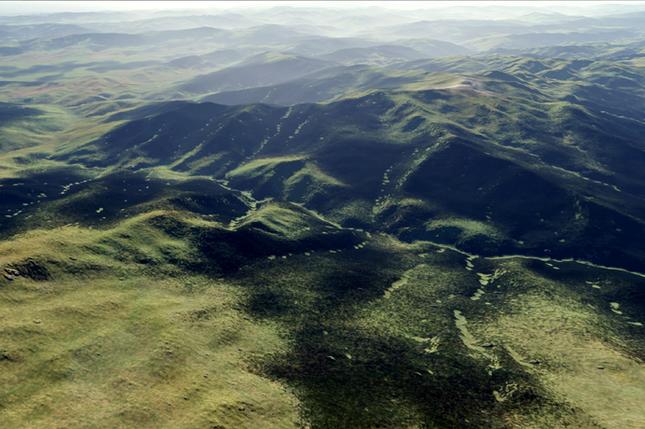Landscapes in an Era of Surveillance
By • July 16, 2014 0 1219

Painting en plein air is a simple artistic ideal, a French expression which means “in the open air.” It calls to mind the sweeping, billowy landscapes of an endless aesthetic tradition.
Artists have long painted outdoors, but the roots of plein air painting took form in the mid-19th century, during an accumulation of technical and conceptual breakthroughs in fine art. First, the Barbizon school and the Impressionists became fixated on capturing natural light in their work, which drove artists to focus more discerningly on the realism of the natural world. Monet’s haystack paintings, for instance, painted during particular times of day, capture the specific effects of atmosphere and light on the environment, a far cry from the generalizing, emotionally driven mountain scenes of Romantic era paintings.
The second factor is the invention around this same time of box easels. Portable, collapsible briefcase-like easels with retractable legs and built-in paint boxes and palettes made the hauling of painting supplies into the wilderness considerably less arduous and cumbersome. Vital to the teachings of art and widely adored by artists, patrons and audiences alike, the tradition of plein air painting remains popular to this day.
The contemporary artist Mark Tribe has taken this art form to a new, strikingly relevant plateau. He brings the tradition of plein air, unapologetically, into the digital age.
Tribe explores the aesthetics and representation of aerial views in landscape photography through the virtual lens of computer simulation in his exhibit, Mark Tribe: Plein Air, which opens to the public on July 19 at the Corcoran Gallery of Art.
Displaying all new work commissioned specifically by the Corcoran, this new exhibit includes nine large-scale images in which Tribe uses geospatial data and fractal algorithms to create digital simulations of real landscapes. Tribe’s shaped prints were made using a UV inkjet printing process on Dibond, a durable aluminum composite material, so that the effect appears to hover over the gallery wall.
The tradition of plein air altered viewers’ perceptions and taught them to see the natural world in new and exciting ways, presenting landscapes with a new eye for composition, light and darkness, the bluish haze of a shadow, for instance, or the rich, monochrome color-muddling of dawn light piercing the sky. Tribe elevates our perception even further, presenting outdoor landscapes from a “drone’s eye view,” a sort of calculated satellite perspective, an intricately pixelated topography that plays an increasingly important and subconsciously familiar role in contemporary culture.
Tribe’s large-scale photographs show a computer-generated world in which familiar environments appear distant, almost foreign. Unlike traditional depictions of landscapes in art, these aerial views shift our perspective. They do not reproduce our “natural” terrestrial viewpoint. There is no ground underfoot, no place to stand, and often no visible horizon. Tribe’s landscapes are idealized and pristine, what he calls “fantastic projections.”
The works grew out of concepts that the artist first examined in his 2012 project, Rare Earth. There, he manipulated landscapes as a symbolic setting for paramilitary fantasy, particularly as used in combat video games (an increasingly rich source of socio-political tension between older and younger generations). This exhibit thus provides an aerial view of such idealized, virtual worlds, which are often depicted as verdant and unspoiled. Collectively, the images collapse the boundaries between the actual and the virtual, the abstract and the representational. They do so in ways that challenge the basic premise of photography and the technological boundaries of image making, while also connecting Tribe’s innovative practices to the historical conventions of landscape painting and photography.
Aside from the plein air tradition, this work also pays homage to the early days of aerial photography, largely developed using balloons for gathering information during the First World War. In 1968, orbiting astronauts first photographed an iconic view of Earth rising over a barren moon—an image that forever changed our notion of landscape as a subject. Since then, military applications of aerial imaging technology has expanded exponentially, from spy planes to satellites and, most recently, to drones.
With this exhibit, Tribe presents a catalog of virtual landscapes that appears to have been shot by drones, interrogating, framing, and critiquing the ways in which landscape images are used to expand territories and defend geopolitical interests. By using software to generate his uncanny panoramas from data, Tribe suggests that the hovering lenses of unmanned devices produce images that can be as powerfully seductive as they are artificial. It is an unsettling prospect, but an oddly beautiful one.

